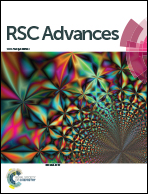Bio-inspired semi-transparent silver nanowire conductor based on a vein network with excellent electromechanical and photothermal properties†
Abstract
A bio-inspired conductive binary-network of vein–silver nanowires (AgNWs) was embedded in poly(dimethylsiloxane) (PDMS) to prepare a semi-transparent stretchable conductor (vein–AgNWs–PDMS) by a simple dipping process. The special conductive structure was constructed by using veins with a porous structure as an ideal skeleton to load AgNW networks, which allowed the vein–AgNWs–PDMS composite to show a low sheet resistance of 1 Ω sq−1 with 74% transmittance. The figure of merit of vein–AgNWs–PDMS is as high as 2502 and can be adjusted easily by controlling the times of the dipping cycle. Furthermore, the vein–AgNWs–PDMS conductor can retain high conductivity after 150% mechanical elongation and exhibit excellent electromechanical stability in repeated stretch/release tests with 60% strain (500 cycles). As an example of an application, patterned light-emitting diode (LED) arrays using the vein–AgNWs–PDMS conductors have been fabricated, and worked well under deformation. Moreover, the photo-thermal properties of the vein–AgNWs–PDMS composite have been demonstrated by a position heating experiment using near-infrared (NIR) laser irradiation and the generated heat can be effectively dissipated through the vein network to avoid local overheating. Due to the high-performance and facile fabrication process, the vein–AgNWs–PDMS conductors will have multifunctional applications in stretchable electronic devices.



 Please wait while we load your content...
Please wait while we load your content...